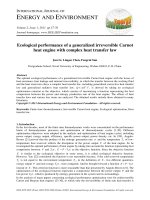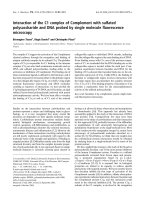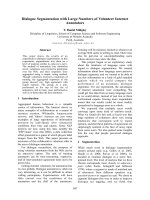AAE556 lecture 23 Representing motion with complex numbers and arithmetic
Bạn đang xem bản rút gọn của tài liệu. Xem và tải ngay bản đầy đủ của tài liệu tại đây (281.23 KB, 26 trang )
AAE 556
Aeroelasticity
Lecture 23
Im
Representing motion with complex
numbers and arithmetic
iωt
f(t)=(a+ib)e
plunge
velocity
+work
b
φ
a
Real
V
plunge
velocity
Our eigenvectors are expressed
as complex numbers
i
h iωt
e
θ
i
i
i
What do you mean,
complex amplitude?
Why are they
complex?
What physical
information is stored
in these vectors?
The most important
information is phase
difference.
Phase definition
lead or lag?
i
i
i
i
Phase is the difference in time
between two events such as
the zero crossing of two
waveforms, or the time
between a reference and the
peak of a waveform.
In our case the waveform is a
sine wave or a cosine wave
The phase is expressed in
degrees
It is also the time between two
events divided by the period
(also a time), times 360
degrees.
Phase relationships
lead and lag
Cosine function “leads”
sine function by 90
degrees - cosine reaches
its max before sine does.
h(t ) = h1 sin ωt
θ (t ) = θ1 cos ωt
Acceleration leads
displacement by 180
degrees
Motion is not purely sine or cosine functions
Harmonic motion is represented as a rotating
vector (a+ib) in a complex plane
e
iωt
= cos ωt + i sin ωt
f = a + ib = re
ωt
f (t ) = ( a + ib ) e
i ( ωt )
iφ iωt
= re e
= re
i ( ωt +φ )
iφ
Flutter phenomena depend on motion
phasing – lead and lag
i
System harmonic motion does not have
the same sine or cosine function
“phase” relationship
h ( t ) = h1 sin ( ω t ) + h2 cos ( ω t )
θ ( t ) = θ1 sin ( ω t ) + θ 2 cos ( ω t )
Not only are the coefficients different, but the relative
sizes (ratios) of the coefficients are different.
How do we represent a sine or cosine
function as a complex vector?
f ( t ) = ( a + ib ) ( eiωt ) = ( a + ib ) ( cos ω t + i sin ω t )
f ( t ) = ( a cos ω t − b sin ω t ) + i ( b cos ω t + a sin ω t )
h ( t ) = h1 sin ( ω t ) + h2 cos ( ω t )
The Real part of the complex function is the
actual motion.
The imaginary part is a by-product
h ( t ) = h1 sin ( ω t ) + h2 cos ( ω t )
f real ( t ) = ( a cos ωt − b sin ωt )
a = h2
b = − h1
h ( t ) = Re ( h ) = Re ( h2 − ih1 ) e
iω t
The phase angle for our
example is negative
h2 − ih1 = ho e = ho ( cos φ + i sin φ )
iφ
h1 = −ho sin φ
h2 = ho cos φ
imaginary
φ
real
− h2
tan φ =
h1
h ( t ) = ho eiφ eiωt = ho e ( iωt +φ )
Aeroelastic vibration mode phasing is
modeled with complex numbers and
vectors
h
cos ωt + i sin ωt
1
iωt
i
ω
t
b e =
e =
θ
+
i
θ
θ
+
i
θ
cos
ω
t
+
i
sin
ω
t
(
)
Imag
Imag )
( Real
Real
θ
h
cos ωt
sin ωt
i
ω
t
b
e =
+i
( θ Real cos ωt − θ Imag sin ωt ) ( θ Real sin ωt + θ Imag cos ωt )
θ
1) The plunge and the twist motions are not “in
phase.”
2) The Real part of the complex function gives us the
expression for the actual motion.
Summary
We have two different types of motion, pitch and plunge
h( t ) = h1 sin( ωt ) + h2 cos( ωt )
(
h( t ) = Re ho e
ho =
2
h1
2
+ h2
i ( ωt +φ )
)
− h2
tan φ =
h1
At the merging point, the frequencies and the mode shapes
become complex and one type of leads by 90 degrees while
the other lags
Jargon and derivatives
dh
i ( ωt +φ )
= h = iωho e
dt
(
h( t ) = Re iωh ei ( ωt +φ )
o
velocity
)
Imaginary
Real
acceleration
The Real part of the complex function is the
actual motion.
The imaginary part is a by-product
Imag
Plunge velocity
downward
Plunge vector
Real
Plunge
acceleration
Torsion vector
(and lift)
Phased motion is the culprit
for flutter
Wair
dh
= − ∫ L dt = −qSCL π hoθ o sin φ
α
dt
π
φ =±
2
plunge
velocity
+work
V
plunge
velocity
φ negative
(torsion lags
displacemen
t) signals
flutter
Flutter occurs when the
frequency becomes complex
quasi-steady flutter mode shape allows lift
- which depends on pitch (twist) to be in
phase with the plunge (bending)
Im
θ,lift
acceleration
plunge
velocity
displacement
Lift, 90 degrees
phase difference
Real
Stability re-visited
(be careful of positive directions)
For the future
An example-forced response of
a damped 1 DOF system
mx + cx + kx = Po cos ω t
Motion is harmonic. The solution for
x(t) is a sine-cosine combination that
has a phase relative to the force.
Two equations are necessary.
x(t ) = x1 cos ω t + x2 sin ω t
Solution approach using complex numbers – put
complexity into the problem with a single
complex equation
Response
(
x( t ) = Re Xe
To forcing
iωt
)
imaginary
φ
real
(
Po cos ωt = Re Po e
iωt
)
Equilibrium
( −mω
2
X + iω cX + kX ) e
iω t
= Po e
iω t
Solution for complex amplitude
Po
X=
2
− mω + iωc + k
(
)
imaginary
Po
X=
− mω 2 + k + iωc
([
]
φ
real
)
Po
X=
(
m
−ω 2 + k + iω c
m
m
)
Solution
Po
X=
(
(
−ω
m
2
)
m
) + (ω c m)
+ ω o2 − iω c
−ω 2 +ω 2
o
2
−ω c
m
φ = tan −1
− ω 2 + ωo2
k
ω =
m
2
o
2
imaginary
φ
real
response X(t) “lags” behind the harmonic force?
Using complex numbers and doing
complex arithmetic provides advantages
i
We use one complex arithmetic
equation instead of two real equations
to find the amplitudes of the motion
The equation of motion solution can be
represented as a vector relationship that
closes
mx + cx + kx = Po cos ω t
Imaginary
P
Real acceleration
kx
x
velocity
Solution for resonant
excitation
mx + cx + kx = Po cos ωt
Po
X=
m
(
−ω + ω − iω c
2
2
o
(
m
)
)
−ω 2 + ω 2 2 + ω c 2
(
÷
o )
m
Resonance definition
Po
X=
(
(
−ω
m
2
o
)
m
) + (ω c m)
+ ω o2 − iω c
2
2 2
− ωo + ωo
Im
acceleration
2
X = −i
Po
ωc
Im
velocity
P
velocity
acceleration
displacement
Real
damping force
Real
P
X
displacement









